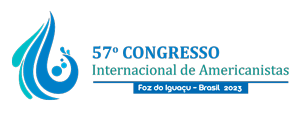| Dados do autor | |
|---|---|
| Nome | Guillermo González Campos |
| E-mail do autor | Email escondido; Javascript é necessário. |
| Sua instituição | Universidad de Costa Rica UCR |
| Sua titulação | Mestre |
| País de origem do autor | Costa Rica |
| Dados co-autor(es) [Máximo de 2 co-autores] | |
| Proposta de Paper | |
| Área Temática | 17. Linguística e Literatura |
| Grupo Temático | Predicados de movimiento en lenguas indígenas de América |
| Título | Morphosyntactic Strategies for Expressing Trajectory of Movement in Chibchan Languages of Costa Rica and Panama |
| Resumo | This paper describes the grammatical structures used by eight Chibchan languages spoken in Costa Rica and Panama to express the trajectory of movement in mono-event predicates. The trajectory is the direction a particular displacement takes concerning the deictic reference point. Talmy's work from the mid-1980s to the late 1990s established a classification of languages into two types: those that express trajectory through the syntactic complexity of the predicate (satellite-framed languages) and those that do so through the lexical properties of the verb (verb-framed languages). Data was collected from various bibliographical sources to determine the type of strategy used by the Chibchan languages of Costa Rica and Panama to encode four types of trajectory: 1) motion with the speaker as the reference point (go/come), 2) vertical trajectory relative to the speaker (go up/go down), 3) horizontal trajectory relative to the speaker (pass by), and 4) motion involving crossing a delimited space boundary (enter/exit). The results reveal that four languages exclusively use lexical constructions (verb-framing): Malecu, Boruca, Teribe, and Cuna. All languages also share this strategy to encode motion concerning the speaker/reference point. Vertical motion and crossing a delimited boundary are coded through complex constructions (verb + satellite) in Bribri, Cabécar, Guaimí, and Buglere. Finally, only Guaimí and Buglere use this strategy to encode horizontal movement. The results indicate a diversity of strategies used in this language family for encoding motion trajectories, some exclusive to specific languages or types of motion. |
| Palavras-chave | |
| Palavras-chave |
|
